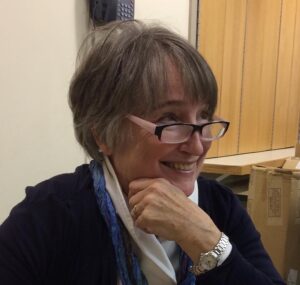Probably from time immemorial writers have found that writing, creative writing in particular, is healing to the soul. When I express in words something that has been vague and unnamed within me, an experience I remember, or something I make up (and fiction is always something within me, something that comes from my imagination, my mind, my body,) then I am feeling more alive. Life is changing and growing within me in that act of creation. Creative writing, or any creative art, is a way of participating in creation itself. So creative expression is a way of being more alive and thus healing to the sick parts of our lives.
As I was writing my first novel, Sea Level, I began to feel elated. Wow, I thought, I can make a story, I can create a scene, I can say something that has never been said before. But suddenly I came to a point in the story where I felt blocked. My main character, Brigid, had come to a crisis in her life, and I couldn’t think how to write her through it. Brigid was the first woman minister in an isolated small town in 1980. Her latent feminism had emerged, people were furious, and now she had to face a meeting of her whole congregation who would vote on whether to fire her.
When I got to this scene, I sat down at my desk to write and nothing came. I let it go for weeks, months, then came back to it. Still nothing. Finally I recognized that I was anxious. And that the anxiety was not only about how to get Brigid through this crucial scene, but it was about me. Brigid’s story was set in an earlier time, she had a very different history and character than I, and I had never faced this situation. But I had been, as she was, the first woman minister in several small churches at a time when there was widespread discrimination and disapprobation of women clergy.
What would it be like, I thought, to face this kind of public disapproval and shaming? It wasn’t so unusual for a woman minister in 1980. Public figures, whether ministers, politicians, or celebrities, are easy targets, and in that era and even now, clergy often have to walk a fine line between maintaining their own integrity and not offending their congregation. I recognized that the fear, the feeling of being vulnerable as a public figure, had been an underlying anxiety in my own time as a parish pastor.
Finally, I sat down determined to plow through this scene. I imagined Brigid’s feelings, the other people, the church, the different speakers, a new crisis that emerged, and finished the scene with a great sigh of relief. Brigid was okay. And I felt better.
In psychology James Pennebaker was the first to study the healing effects of writing. In the 1980s he had students and other groups write personal stories about traumas or the difficult times in their lives. He developed a method where each person would write for twenty minutes, and only twenty minutes, a day, describing some crisis in their life. He discovered that not only did they feel better afterward, but there were positive changes in heart rate, blood pressure and the immune system. His premise was that it is the inhibited, avoided parts of ourselves that bock our life energy, and when we allow what has been suppressed or inhibited to come out, put it in words, we begin to see an order in our lives, a meaning, and thus find a new perspective.
As Pennybaker discovered, too, the kind of writing makes a difference. I have a friend who wrote journals where he listed all the things he was angry about and all the criticisms his wife had aimed at him. Needless to say, that made him feel worse.
But both Pennybaker and creative writers throughout history have known that the most life-giving writing, even journal writing, is what one of my first writing teachers called “rendering.” When you render a scene, you remember or imagine not only what you feel, but what you (or your character) see, hear, smell. The anger, the fear, can be a part of it, but in the process of rendering it becomes transformed.
I love what Alice Walker said about the creative process: “In Native American cultures, when you feel sick at heart, sick in your soul, you do sand paintings. Or you make a basket. The thing is that you are focused on creating something. And while you’re doing that, there’s a kind of spiritual alchemy that happens, and you turn that bad feeling into something that becomes a golden light. It’s all because you are intensely creating something that is beautiful. And…by the time you’ve finished the sand painting, you’re well. The point is to heal yourself.”
